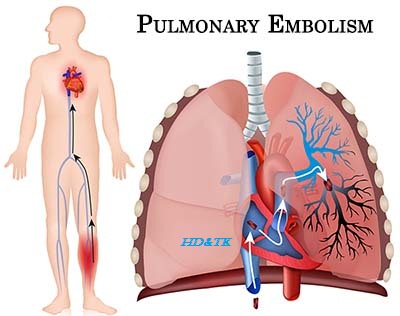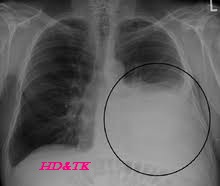Prolactin is
a hormone produced in the pituitary gland, named because of its role in
lactation. Prolactin is a hormone named originally after its
function to promote milk production (lactation) in mammals in response to the
suckling of young after birth.
Lesions
of the hypothalamic-pituitary region that disrupt hypothalamic dopamine
synthesis, portal vessel delivery, or lactotrope responses are associated with
hyperprolactinemia. Thus, hypothalamic tumors, cysts, infiltrative disorders,
and radiation-induced damage cause elevated PRL levels, usually in the range of
30–100 µg/L. Plurihormonal adenomas (including GH and ACTH tumors) may directly
hypersecrete PRL. Pituitary masses, including clinically nonfunctioning
pituitary tumors, may compress the pituitary stalk to cause hyperprolactinemia.
Drug-induced
inhibition or disruption of dopaminergic receptor function is a common cause of
hyperprolactinemia (Table 2-8). Thus, antipsychotics and antidepressants are a
relatively common cause of mild hyperprolactinemia. Methyldopa inhibits
dopamine synthesis and verapamil blocks dopamine release, also leading to
hyperprolactinemia. Hormonal agents that induce PRL include estrogens,
antiandrogens, and TRH.
Lesions of the hypothalamic-pituitary region that disrupt hypothalamic dopamine synthesis, portal vessel delivery, or lactotrope responses are associated with hyperprolactinemia. Thus, hypothalamic tumors, cysts, infiltrative disorders, and radiation-induced damage cause elevated PRL levels, usually in the range of 30–100 µg/L. Plurihormonal adenomas (including GH and ACTH tumors) may directly hypersecrete PRL. Pituitary masses, including clinically nonfunctioning pituitary tumors, may compress the pituitary stalk to cause hyperprolactinemia.
Treatment:
Hyperprolactinemia
Treatment of hyperprolactinemia depends on the cause
of elevated PRL levels. Regardless of the etiology, however, treatment should
be aimed at normalizing PRL levels to alleviate suppressive effects on
gonadal function, halt galactorrhea,and preserve bone mineral density.
Dopamine agonists are effective for many different causes of
hyperprolactinemia.
If the patient is taking a medication known to cause
hyperprolactinemia, the drug should be withdrawn, if possible. For
psychiatric patients who require neuroleptic agents, dose titration or the
addition of a dopamine agonist can help restore normoprolactinemia and
alleviate reproductive symptoms. However, dopamine agonists sometimes worsen
the underlying psychiatric condition, especially at high doses.
Hyperprolactinemia usually resolves after adequate thyroid hormone
replacement in hypothyroid patients or after renal transplantation in
patients undergoing dialysis. Resection of hypothalamic or sellar mass
lesions can reverse hyperprolactinemia caused by reduced dopamine tone.
Granulomatous infiltrates occasionally respond to glucocorticoid
administration. In patients with irreversible hypothalamic damage, no
treatment may be warranted. In up to 30% of patients with
hyperprolactinemia—with or without a visible pituitary microadenoma—the
condition resolves spontaneously
|
Prolactinoma
Etiology
and Prevalence
Tumors
arising from lactotrope cells account for about half of all functioning
pituitary tumors, with an annual incidence of ~3/100,000 population. Mixed
tumors secreting combinations of GH and PRL,ACTH and PRL, and, rarely, TSH and
PRL are also seen. These plurihormonal tumors are usually recognized by
immunohistochemistry, often without apparent clinical manifestations from the
production of additional hormones. Microadenomas are classified as <1 cm in
diameter and do not usually invade the parasellar region. Macroadenomas are
>1 cm in diameter and may be locally invasive and impinge on adjacent
structures.The female/male ratio for microprolactinomas is 20:1, whereas the
gender ratio is near 1:1 for macroadenomas.Tumor size generally correlates
directly with PRL concentrations; values >100 µg/L are usually associated
with macroadenomas. Men tend to present with larger tumors than women, possibly
because the features of hypogonadism are less readily evident. PRL levels
remain stable in most patients, reflecting the slow growth of these
tumors.About 5% of microadenomas progress in the long term to macroadenomas.
Hyperprolactinemia resolves spontaneously in about 30% of microadenomas.
Presentation
and Diagnosis
Women
usually present with amenorrhea, infertility, and galactorrhea. If the tumor
extends outside of the sella, visual field defects or other mass effects may be
seen. Men often present with impotence, loss of libido, infertility, or signs
of central CNS compression including headaches and visual defects. Assuming
that physiologic and medication-induced causes of hyperprolactinemia are
excluded. The diagnosis of prolactinoma is likely with a PRL level >100
µg/L. PRL levels <100 µg/L may be caused by microadenomas, other sellar
lesions that decrease dopamine inhibition, or nonneoplastic causes of
hyperprolactinemia. For this reason, an MRI should be performed in all patients
with hyperprolactinemia. It is important to remember that hyperprolactinemia
caused secondarily by the mass effects of nonlactotrope lesions is also
corrected by treatment with dopamine agonists, despite failure to shrink the
underlying mass. Consequently, PRL suppression by dopamine agonists does not
necessarily indicate that the lesion is a prolactinoma.
Treatment:
Polactinoma
As
microadenomas rarely progress to become macroadenomas, no treatment may be
needed if fertility is not desired. Estrogen replacement is indicated to
prevent bone loss and other consequences of hypoestrogenemia and does not
appear to increase the risk of tumor enlargement. These patients should be
monitored by regular serial PRL and MRI measurements.
For
symptomatic microadenomas, therapeutic goals include control of
hyperprolactinemia, reduction of tumor size, restoration of menses and
fertility, and resolution of galactorrhea. Dopamine agonist doses should be
titrated to achieve maximal PRL suppression and restoration of reproductive
function. A normalized PRL level does not ensure reduced tumor size. However,
tumor shrinkage is not usually seen in those who do not respond with lowered
PRL levels. For macroadenomas, formal visual field testing should be performed
before initiating dopamine agonists. MRI and visual fields should be assessed
at 6- to 12-month intervals until the mass shrinks and annually thereafter until
maximum size reduction has occurred.
Medical Oral dopamine agonists
(cabergoline or bromocriptine) are the mainstay of therapy for patients with
micro- or macroprolactinomas. Dopamine agonists suppress PRL secretion and
synthesis as well as lactotrope cell proliferation. About 20% of patients are
resistant to dopaminergic treatment; these adenomas may exhibit decreased D2
dopamine receptor numbers or a postreceptor defect. D2 receptor gene mutations
in the pituitary have not been reported.
Cabergoline An ergoline
derivative, cabergoline is a long-acting dopamine agonist with high D2 receptor
affinity. The drug effectively suppresses PRL for >14 days after a single
oral dose and induces prolactinoma shrinkage in most patients. Cabergoline (0.5
to 1.0 mg twice weekly) achieves normoprolactinemia and resumption of normal
gonadal function in ~80% of patients with microadenomas; galactorrhea improves
or resolves in 90% of patients. Cabergoline normalizes
PRL
and shrinks ~70% of macroprolactinomas. Mass effect symptoms, including
headaches and visual disorders, usually improve dramatically within days after
cabergoline initiation; improvement of sexual function requires several weeks
of treatment but may occur before complete normalization of prolactin levels.
After initial control of PRL levels has been achieved, cabergoline should be
reduced to the lowest effective maintenance dose. In ~5% of treated patients,
hyperprolactinemia may resolve and not recur when dopamine agonists are
discontinued after long-term treatment. Cabergoline may also be effective in
patients resistant to bromocriptine. Adverse effects and drug intolerance are
encountered less commonly than with bromocriptine.
Bromocriptine The ergot alkaloid
bromocriptine mesylate is a dopamine receptor agonist that suppresses prolactin
secretion. Because it is short-acting, the drug is preferred when pregnancy is
desired. In patients with microadenomas, bromocriptine rapidly lowers serum
prolactin levels to normal in up to 70% of patients, decreases tumor size, and
restores gonadal function. In patients with macroadenomas, prolactin levels are
also normalized in 70% of patients and tumor mass shrinkage (≥50%) is achieved
in up to 40% of patients.
Therapy
is initiated by administering a low bromocriptine dose (0.625–1.25 mg) at
bedtime with a snack, followed by gradually increasing the dose. Most patients
are successfully controlled with a daily dose of <7.5 mg (2.5 mg
tid).
Other
Dopamine Agonists: These include pergolide mesylate, an
ergot derivative with dopaminergic properties; lisuride, an ergot derivative;
and quinagolide (CV 205-502, Norprolac), a nonergot oral dopamine agonist with
specific D2 receptor activity.
Side
Effects Side effects of dopamine agonists
include constipation, nasal stuffiness, dry mouth, nightmares, insomnia, and
vertigo; decreasing the dose usually alleviates these problems. Nausea,
vomiting, and postural hypotension with faintness may occur in ~25% of patients
after the initial dose. These symptoms may persist in some patients. In
general, fewer side effects are reported with cabergoline. For the
approximately 15% of patients who are intolerant of oral bromocriptine,
cabergoline may be better tolerated. Intravaginal administration of
bromocriptine is often efficacious in patients with intractable
gastrointestinal side effects. Auditory hallucinations, delusions, and mood
swings have been reported in up to 5% of patients and may be due to the
dopamine agonist properties or to the lysergic acid derivative of the
compounds. Rare reports of leukopenia, thrombocytopenia, pleural fibrosis,
cardiac arrhythmias,and hepatitis have been described.
Surgery Indications for
surgical adenoma debulking include dopamine resistance or intolerance, or the
presence of an invasive macroadenoma with compromised vision that fails to
improve after drug treatment. Initial PRL normalization is achieved in about
70% of microprolactinomas after surgical resection, but only 30% of
macroadenomas can be successfully resected. Follow-up studies have shown that
hyperprolactinemia recurs in up to 20% of patients within the first year after
surgery; long-term recurrence rates exceed 50% for macroadenomas. Radiotherapy
for prolactinomas is reserved for patients with aggressive tumors that do not
respond to maximally tolerated dopamine agonists and/or surgery.
Pregnancy: The
pituitary increases in size during pregnancy, reflecting the stimulatory
effects of estrogen and perhaps other growth factors. About 5% of microadenomas
significantly increase in size, but 15–30% of macroadenomas grow during
pregnancy. Bromocriptine has been used for more than 30 years to restore
fertility in women with hyperprolactinemia, without evidence of teratogenic
effects. Nonetheless, most authorities recommend strategies to minimize fetal
exposure to the drug. For women taking bromocriptine who desire pregnancy,
mechanical contraception should be used through three regular menstrual cycles
to allow for conception timing. When pregnancy is confirmed, bromocriptine
should be discontinued and PRL levels followed serially, especially if
headaches or visual symptoms occur. For women harboring macroadenomas, regular
visual field testing is recommended, and the drug should be reinstituted if
tumor growth is apparent. Although pituitary MRI may be safe during pregnancy,
this procedure should be reserved for symptomatic patients with severe headache
and/or visual field defects. Surgical decompression may be indicated if vision
is threatened. Although comprehensive data support the efficacy and relative
safety of bromocriptine-facilitated fertility, patients should be advised of
potential unknown deleterious effects and the risk of tumor growth during
pregnancy. As cabergoline is long-acting with a high D2- receptor affinity, it
is not approved for use in women when fertility is desired.




Comments
Post a Comment